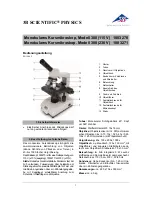
4
3. Operation
Up
Fig.1
3.1 Use black and white work board
(1) If the specimen is white or transparent, make the black one as
background, to enhance the contrast.
(2) Take off or change the work board, move the work board (Fig.1)
make one side down, then the other side will be up.(Fig. 1)
Adjust the degree of tightness of the focusing arm.
Loose
Fig.2
Tension
(1) If you want to adjust tightness of the focusing arm, you can
hold one of the focusing knobs and turn another one to attain a
suitable tightness. The degree of tightness relies on the
direction to be turned. The reverse direction is tight, otherwise, is
loose.
(2)The suitable position of tightness can make the adjustment
more comfortable and prevent the focusing bracket from slipping
down by its weight during the observation. (Fig.2)
Set the specimen slide
(1) Set the specimen on the center of stage plate. If necessary,
clamp the slide with the clips.
(2)Turn on the light.
Left eyepiece
diopter adjustable
loop
Right eyepiece
diopter adjustable
loop
Fig.3
Adjust the specimen slide
(1) Turn the zoom control knob to the maximum magnification.
(2) Turn the diopter adjusting rings to the zero.
(3) Observe the specimen through the right eyepiece and make
the image clear by turning the focusing knob.
(4) Rotate the zoom control knob to the minimum magnification.
(5) Observe the specimen through the right eyepiece and make
the image clear by turning the right diopter adjusting ring.(Fig.3)
(6) Re-do the step(3)and (5) till the right adjusting ring is more precise.
(7) Do the step (4) and make the image clear which is observed
through the left eyepiece by turning the left diopter adjusting ring.
(Fig.3)






















